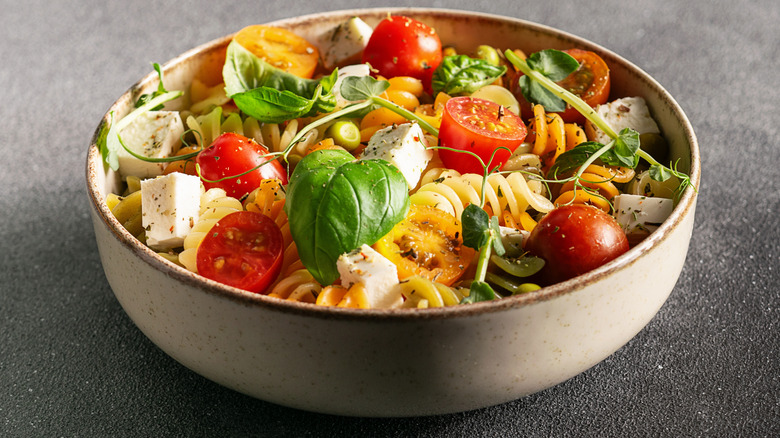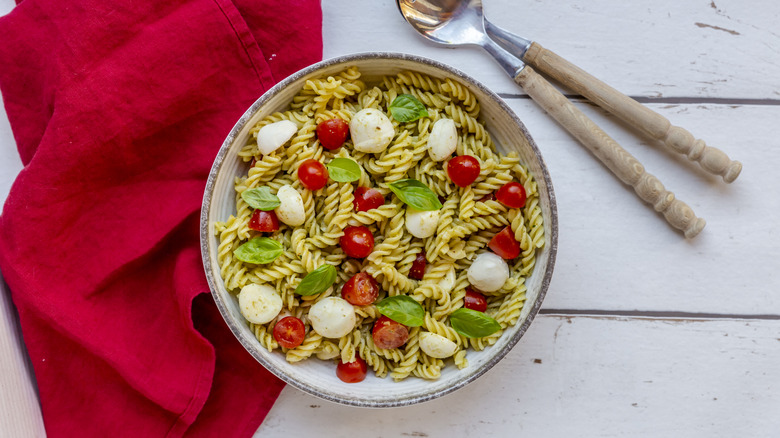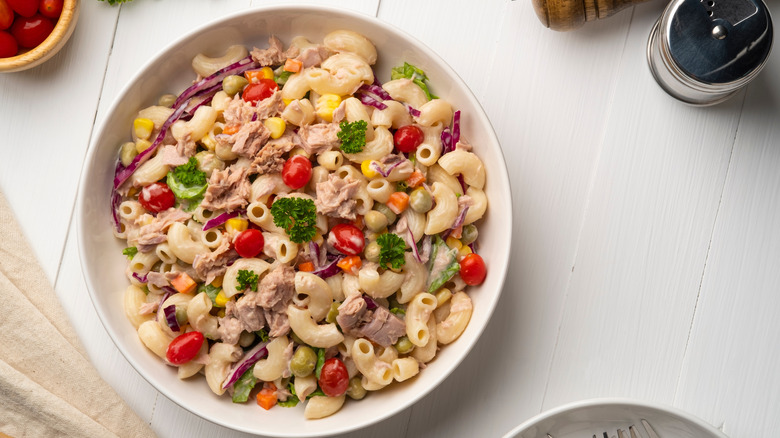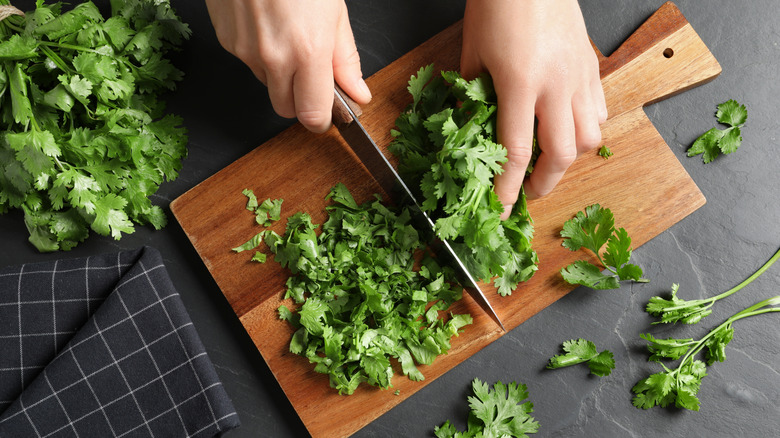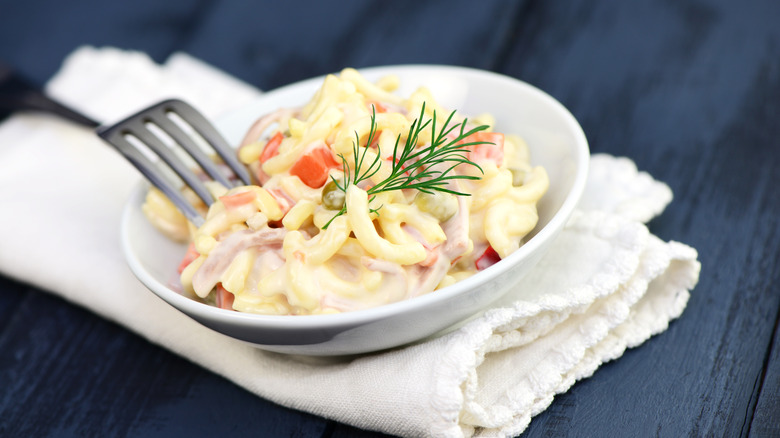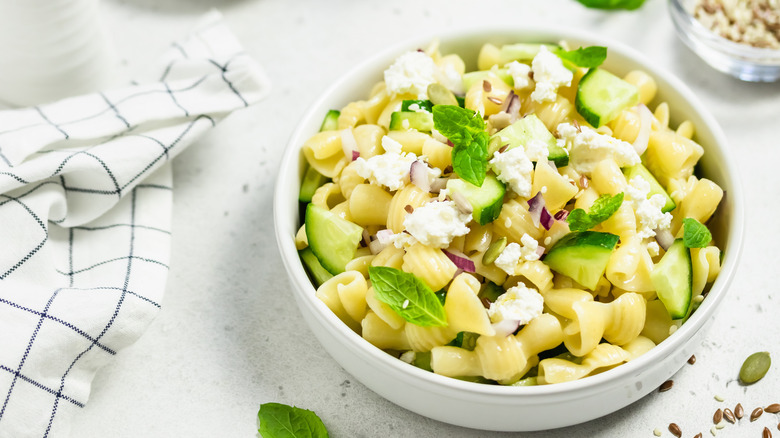The 5 Best Herbs To Add To Pasta Salad
Pasta salad is one of those dishes that feels just as at home at a casual picnic as it does at a fancy holiday feast. It's easy to make, fresh yet filling, customizable with your favorite dressing, protein, and veggies, and overall a crowd favorite. Yet an often forgotten — but equally important — element of pasta salad is one that adds aromatics, flavor, and a pop of color to your meal: herbs.
While an epic pasta salad starts with the right pasta shapes, a well-chosen herb can turn your one-note meal into a symphony of flavor. From accentuating tangy vinaigrettes to balancing rich cheeses, herbs have the ability to tie your entire dish together. It's important, however, to know which ones work best for different variations of pasta salad. Luckily for you, we've whittled it down to the five best herbs you should keep on hand for your next pasta salad night.
Basil
Basil is considered one of the most classic herbs you can find in a pasta salad — and for good reason. It adds freshness and a unique, delicious flavor, as well as a strong, aromatic element that enhances the eating experience.
If you want to add basil to your dish, it's best paired with Italian-inspired pasta salads, such as a Caprese-style pasta salad with basil, tomatoes, mozzarella balls, and balsamic dressing. Or, try a bright spin on pasta salad with lemon, basil, olive oil, and parmesan. Since basil plants have relatively large leaves, it's best to julienne-cut them into long, fine strips.
Parsley
Parsley is one of those herbs that can do it all — you can find it in hearty soups, vibrant chimichurri sauce, or atop a wild rice pilaf. But parsley is far more than a simple garnish, especially for pasta salads.
Parsley's slightly bitter, earthy, and fresh flavor brightens up pasta salads with salty or rich ingredients, such as olives, canned fish, cheese, and salami. Both curly leaf and flat-leaf parsley work, although flat-leaf parsley is more commonly used for its pronounced flavor in dishes, while curly leaf is often used as a garnish.
Cilantro
When you think of cilantro, the first thing that might come to mind is Mexican-inspired dishes, such as tacos, guacamole, or grilled Mexican street corn salad. Or perhaps you envision delicious Thai dishes, like Thai coconut chicken soup or Thai fried rice. No matter which cuisine you associate with cilantro, why not reinterpret it for a pasta salad?
For example, make a fresh Southwestern pasta salad with corn, black beans, avocado, and cilantro. Or, try pasta salad with a Thai-peanut sauce, carrots, cabbage, and a heap of cilantro on top. It's sure to add a zesty and vibrant flavor profile to your dish.
Dill
Dill might not be the first herb you reach for when making pasta salad, but hear us out. Its distinctive, somewhat grassy taste is perfect for balancing out particularly acidic or creamy dishes, like in a grilled potato salad with feta and dill.
If you're making a creamy macaroni salad or a Mediterranean-inspired pasta salad with tomatoes, feta, cucumbers, and red onion, dill is the perfect addition to bring in herbaceous, clean notes. Just don't forget to chop off the dill stems (as they can be tough and bitter), and stick to the feathery fronds of the herb.
Mint
You might already love mint in your mojitos or ice cream, but it also adds a slightly sweet, bright coolness to any pasta salad dish. Similar to dill, mint is most often found in Mediterranean-style dishes and pairs well with salty and citrus flavors, such as lemons, capers, feta, or olives.
To make your pasta salad heartier, mix in mint with grilled shrimp, chicken, or chickpeas for a balanced, refreshing bite. Since mint has a rather strong, distinctive flavor, be sure to finely chop each leaf to evenly distribute it throughout your dish.

